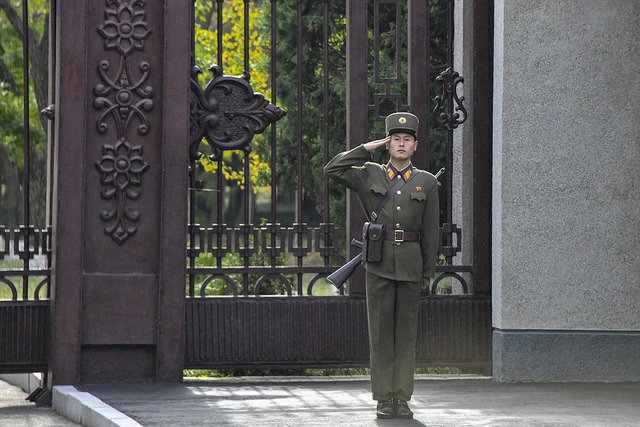
North Korea set out on its quest to develop a nuclear-weapons capability (reliable nuclear explosive devices and the means to deliver them over medium and long distances) in the mid-1980s. Progress was slow and uneven. The DPRK lacked financial resources and technological capacities. All the countries that possessed the relevant technologies paid at least lip service to nuclear non-proliferation and had export controls on the core technologies, including China, through which the great bulk of North Korea’s trade has transited since the demise of the USSR.
Two major efforts were made to dissuade Pyongyang from proceeding with its nuclear program—a freeze agreed with the US in 1994, which was to be followed by the verified dismantling of the DPRK’s nuclear capabilities, and the six-party talks of 2003–2005, which had the same objective.
North Korea tested its first nuclear device in 2006, and five subsequent tests through 2017 confirmed its competence in making nuclear explosive devices. The testing was accompanied by what a surprisingly rapid mastery of building ballistic missiles capable of delivering nuclear warheads over distances as far as the west coast of the United States.
The blizzard of missile tests in 2016 and 2017 generated an acute sense of crisis that was abruptly defused at the end of 2017 when the DPRK used the Winter Olympics being hosted by South Korea to revive dormant channels of communication, first with Seoul and Beijing, and then with Washington.
North Korea’s achievement of a genuine nuclear-weapons capability was remarkable but, in a crucially important sense, not surprising. Indeed, it’s consistent with the pronounced belligerence that has characterised the regime since its emergence under the wing of the USSR shortly after World War II ended.
Its first leader, Kim Il-sung, began lobbying the Soviet leader to support the invasion of the South and bring the entire peninsula into the socialist camp. Stalin eventually agreed that it was an attractive idea, but insisted that the People’s Republic of China also agree to support the venture. Mao agreed and North Korean forces struck on 25 June 1950. The war ended more than three years later with an armistice agreement that is still in place.
North Korea, though economically depleted, maintained its aspiration to unite the two Koreas on its terms and set out to steadily increase its armed forces. A quarter of a century later—a period interspersed with acts of extreme belligerence towards the South in particular—they topped 1.1 million personnel, rendering the DPRK the most militarised state in the world but also among the poorest.
The subsequent commitment to nuclear weapons appears to have emerged from the assessment that, despite facing in the US an implacable enemy seeking a second chance to terminate it, the DPRK could not support the continual modernisation of such a massive force. For essentially all of this period, Russia and China have gone along with the DPRK, declining to compel or even encourage it to amend its national story and strive to coexist with its neighbours and the wider world in the normal way.
US President Donald Trump brashly agreed to meet his North Korean counterpart, Kim Jong-un, in Singapore in June last year and resolved to honour that commitment despite the North’s firmly resisting all efforts to flesh out what was at stake or how the parties might begin to address the issues between them. At the conclusion of the Singapore summit, North Korea raced to occupy the moral high ground, insisting that it had endured decades of US aggression and that the US had a major trust deficit to make up—particularly through easing the sanctions regime and transforming the armistice into a peace treaty—before the DPRK could even begin to consider reciprocal steps. The US went through the motions of asking the DPRK to draw up a baseline inventory of its nuclear assets and facilities as a prelude to joint development of a schedule to eliminate them, but the entire process fell flat very quickly.
A second summit will be held in Hanoi, Vietnam, later this week. There’s still little evidence of new flexibility on either side. Kim and Trump have corresponded since Singapore and the new US special envoy has spent some days in Pyongyang. This may point towards the painstaking incremental, action-for-action approach agreed in broad terms at the six-party talks in September 2005.
In addition, Kim met again with Chinese President Xi Jinping in mid-January 2019—their fourth meeting in less than a year after six years without any meetings. We have no visibility of how North Korea’s objectives and tactics may have been influenced by China. China did at several points lose patience with North Korea, especially when its actions threatened a full-blown crisis that could have spun out of control and prove costly to China’s long-term interests.
Broadly speaking, we can assume that China has reaffirmed its willingness to stand behind the DPRK economically and politically, provided Pyongyang remains receptive to China’s counsel on how best to manage the issue in a way that protects China’s primary interest—a US position in Northeast Asia that has been weakened rather than reinforced. Trump, meanwhile, has been highlighting the economic bonanza that denuking could deliver for the DPRK.
An even more important reason to be skeptical about a breakthrough at the Hanoi summit is that the main players continue to cling to very divergent narratives on how we got to where we are. The background rehearsed so briefly above—a few highlights from the ‘Western’ record—has been completely buried. We cannot expect a shared narrative.
Nor can issues of this kind be resolved through any kind of simple reckoning of past injustices. That said, however, it’s difficult to see how a meeting of the minds sufficiently strong and deep to reach and to implement a denuclearisation agreement can happen if the two principals clash so spectacularly on how and why the situation is in its current shape.

